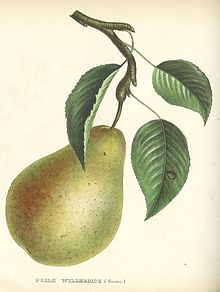Pomology

Pomology (from
agricultural practice of growing fruits in orchards
.
Pomological research is mainly focused on the development, enhancement, cultivation, and physiological studies of
production costs
.
History
Middle East
In ancient Mesopotamia, pomology was practiced by the
Europe
The ancient Greeks and Romans also had a strong tradition of pomology, and they cultivated a wide range of fruits, including
medlars. Cherries and apricots, both introduced in the 1st century BC, were popular. Peaches were introduced in the 1st century AD from Persia. Oranges and lemons were known but used more for medicinal purposes than in cookery. The Romans, in particular, were known for their advanced methods of fruit cultivation and storage, and they developed many of the techniques that are still used in modern pomology.[4]
United States
During the mid-19th century in the
USDA and agricultural colleges were bringing new varieties to the US from foreign expeditions, and developing experimental lots for these fruits. In response to this increased interest and activity, the USDA established the Division of Pomology in 1886 and named Henry E. Van Deman as chief pomologist. An important focus of the division was to publish illustrated accounts of new varieties and to disseminate research findings to fruit growers and breeders through special publications and annual reports. During this period Andrew Jackson Downing and his brother Charles were prominent in pomology and horticulture, producing The Fruits and Fruit Trees of America (1845).[5]
The introduction of new varieties required an exact depiction of the fruit so that plant breeders could accurately document and disseminate their research results. Since the use of
horticulturists, historians, artists, and publishers.[citation needed
]
See also
References
- ^ "Farming". British Museum. Archived from the original on 16 June 2016. Retrieved 15 June 2016.
- ^ Tannahill, Reay (1968). The fine art of food. Folio Society.
- ISBN 9780470650301.
- ^ a b John E. Stambaugh, The Ancient Roman City, JHU Press (1988), p. 148.
- ^ Downing, Andrew Jackson (1855). The Fruits and Fruit Trees of America (1845) online.
- National Agricultural Library. Archived from the originalon 2011-01-09. Retrieved 2009-03-08.
External links
- American Pomological Society — oldest fruit organization in North America
- German Pomological Society — German fruit organization
